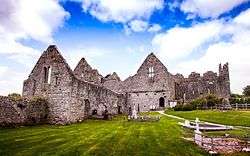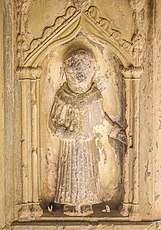Askeaton Abbey
Askeaton Abbey or Askeaton Friary is a former Franciscan monastery and National Monument located in County Limerick, Ireland.[1][2][3][4][5][6]
Mainistir Eas Géitine | |
 | |
 Location within Ireland | |
| Monastery information | |
|---|---|
| Other names | Athskettin; Easa-geibhteine; Es-geibhteine; Inis-geibhthine; Easa-gebryny; Inisgebryny? |
| Order | Order of Friars Minor Conventual Order of Friars Minor |
| Established | 1389–1420 |
| Disestablished | 1714 |
| Diocese | Limerick |
| People | |
| Founder(s) | Gerald FitzGerald, 3rd Earl of Desmond |
| Architecture | |
| Status | Inactive |
| Site | |
| Location | Moig South, Askeaton, County Limerick |
| Coordinates | 52.603813°N 8.975413°W |
| Visible remains | church, north transept, sacristy, cloister arcade, domestic buildings |
| Public access | Yes |
National Monument of Ireland | |
| Official name | Askeaton Abbey |
| Reference no. | 185 |
Location
Askeaton Abbey is located in the north of Askeaton, on the east bank of the River Deel.[7][8][9]
History

Askeaton Abbey was founded for the Order of Friars Minor Conventual by Gerald FitzGerald, 3rd Earl of Desmond between 1389 and 1400; or by James FitzGerald, 6th Earl of Desmond in 1420.[10]
The abbey was reformed under the Order of Friars Minor in 1490; it was reformed again in 1513 and a provincial chapter held there in 1564.[11]
Askeaton was plundered and later abandoned by Nicholas Malby's men in 1579 during the Second Desmond Rebellion, and some of the friars were killed.[12] It was revived in 1627 and abandoned in 1648 when Cromwell’s forces neared. It was reestablished in 1658 and continued to house friars until 1714.[13]
Remains
_(14764772525).jpg)
The church and its north transept, sacristy, cloister arcade and domestic buildings survive. Notable features include the cloister with its carvings of Francis of Assisi with stigmata, a Mass dial, sedilia, several Fitzgerald dynasty tombs, and a carving of Christ as the Man of Sorrows.[10][14][15][16][17]
References
- Rae, Edwin (February 11, 2009). "Askeaton Friary, Askeaton, County Limerick - Cloister" – via www.tara.tcd.ie. Cite journal requires
|journal=(help) - "Askeaton". The Irish Aesthete.
- McNeill, T. E. (August 18, 2005). Castles in Ireland: Feudal Power in a Gaelic World. Routledge. ISBN 9781134708864 – via Google Books.
- Hourihane, Colum (November 18, 2000). The Mason and His Mark: Masons' Marks in the Medieval Irish Archbishoprics of Cashel and Dublin. British Archaeological Reports Limited. ISBN 9781841711324 – via Google Books.
- Salter, Mike (November 18, 2009). Abbeys and Friaries of Ireland. Folly Publications. ISBN 9781871731842 – via Google Books.
- Wordsworth, William (November 18, 1969). "Letters of the Wordsworth Family from 1787-1855". Ardent Media – via Google Books.
- Fernie, E. C.; Crossley, Paul (January 1, 1990). Medieval Architecture and Its Intellectual Context: Studies in Honour of Peter Kidson. A&C Black. ISBN 9781852850340 – via Google Books.
- "Askeaton Abbey". dúchas.ie.
- Westropp, Thomas J. (1903). "Notes on Askeaton, County Limerick. Part III. The "Abbey" (Continued)". The Journal of the Royal Society of Antiquaries of Ireland. 33 (3): 239–254. JSTOR 25507304.
- "Askeaton Franciscan Friary | Monastic Ireland".
- "A visit to Askeaton Friary". April 30, 2017.
- Berleth, Richard (June 25, 2002). The Twilight Lords: Elizabeth I and the First Irish Holocaust. Roberts Rinehart. ISBN 9781461733478 – via Google Books.
- "Askeaton Franciscan Friary, Askeaton. County Limerick 1398".
- Comerford, Patrick. "Strolling through the beautiful cloisters in Askeaton Friary".
- "Askeaton Friary, Co. Limerick".
- Leask, Harold Graham (November 18, 1955). "Irish Churches and Monastic Buildings". Dundalgan Press – via Google Books.
- "Franciscan Monastery, Limerick". www.libraryireland.com.





